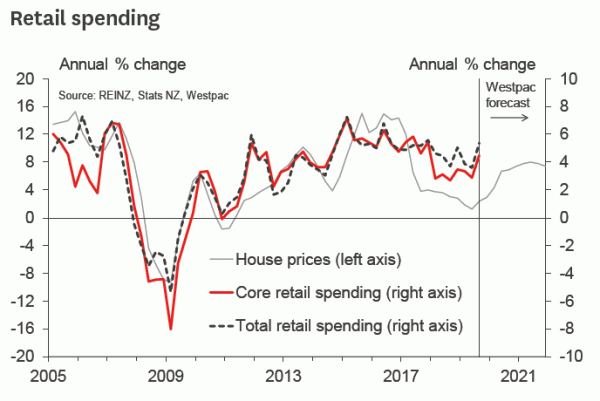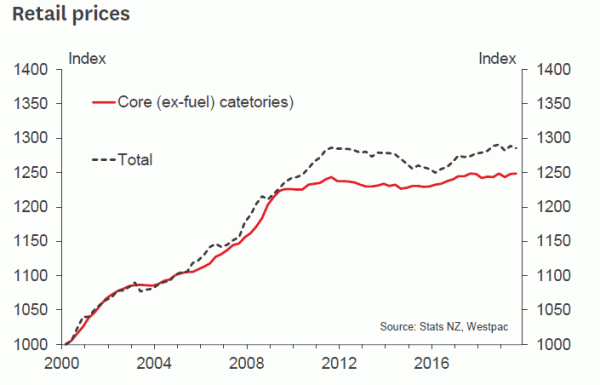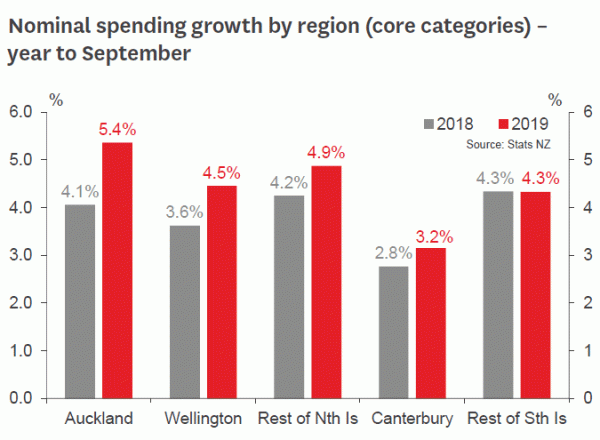- Retail spending rose by 1.6% in the September quarter. That was a little above our forecast for a 1.4% rise and well above the average market forecast for a 0.5% gain.
- Today’s result supports our view that New Zealand’s economic cycle is starting to turn, with the pickup in the housing market an important boost for spending appetites.
- We expect to see retail spending levels continuing to rise over the coming year, supported by low interest rates and increases in Government spending.
- Retail price growth remains muted
Spending appetites have picked up…
After sluggish spending growth through the first half of the year, New Zealand households have thrown their purses and wallets open again. Retail spending levels rose a strong 1.6% over the September quarter (excluding price changes). That was underpinned by a solid 1.% increase in core (ex-fuel and motor vehicle) categories. Today’s result was close to our forecast for a 1.4% increase, but well above the average market forecast for a 0.5% gain.
September’s increase in spending was widespread across retail categories. There were notable increases in areas like electronics and household furnishings. Spending was also up in department stores and supermarkets.
September’s strong rise follows limited growth through the first half of the year, but still leaves spending levels up 4.5% compared to September 2018.
…with continued strength expected over the coming year.
It wouldn’t be surprising to see spending in some categories pulling back in the final part of 2019. Spending in areas like electronics and furnishings, which accounted for much of the September increase, does tend to be ‘lumpy’ on a quarter to quarter basis. In fact, we’ve already seen some moderation in monthly electronic card spending figures for October. Nevertheless, we’re optimistic about the longer-term trajectory for retail spending. The widespread gains over the September quarter support our view that New Zealand’s economic cycle is starting to turn. Low interest rates are boosting the housing market, and that in turn is boosting spending appetites.
Combined with increases in Government spending, we expect that low interest rates will see retail spending continuing to lift over the year ahead. However, the extent of those increases might be more modest than in previous years now that population growth is past its peak. Price growth still muted.
Even with a pickup in spending, price growth in the retail sector remains weak. Prices in core (ex-fuel and motor vehicle) categories rose by only 0.1% in the September quarter and they’re up just 0.4% over the past 12 months. As we’ve previously highlighted, a range of factors has been limiting retail price increases. The most important of these has been strong competitive pressures, including those related to online trading which has essentially increased the presence of large global retailers in the New Zealand market. If demand continues to firm as we expect, price growth is likely to pick up a little over the coming year. However, ongoing competitive pressures mean that any such lift is likely to be modest.
While price growth remains weak, increasing numbers of retailers are highlighting upward pressure on costs, particularly in relation to wages. That has seen pressure on margins and profitability.
Regional breakdown.
Spending growth remains strongest in North Island centres, with particularly strong growth in Bay of Plenty and Hawke’s Bay. Many regions in the central and lower North Island are enjoying a combination of strong export incomes, rapid house price growth and continued population gains – all of which are helping to boost spending. Spending has also been picking up in Wellington.
Spending in Auckland was up more than 5% over the past year. After a sluggish start to the year, spending in Auckland is now rising at a strong pace. In contrast to many other regions, Auckland’s housing market has been very weak in recent years. That dampened spending appetites and offset some of the boost to demand from strong population increases. But with the regions housing market now awakening from its slumber, spending is also picking up. We expect this to continue over the coming year.
In recent years spending in Canterbury has struggled as the boost to demand from reconstruction spending has faded. However, recent months have seen spending in the region reaccelerating as the economy transitions away from construction-led growth.
Nominal spending growth by region (core categories) – year to September














